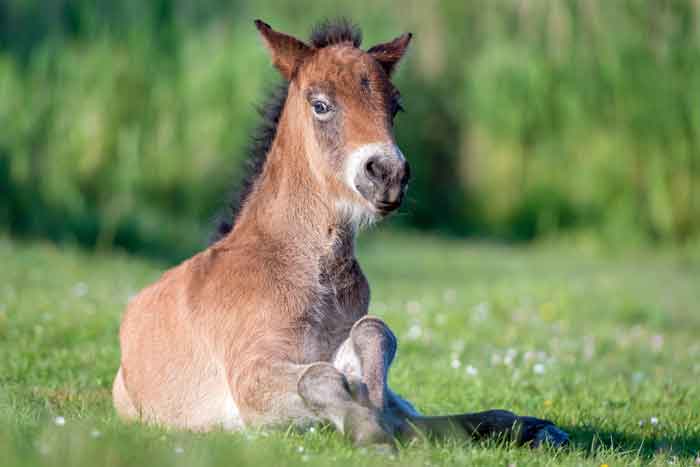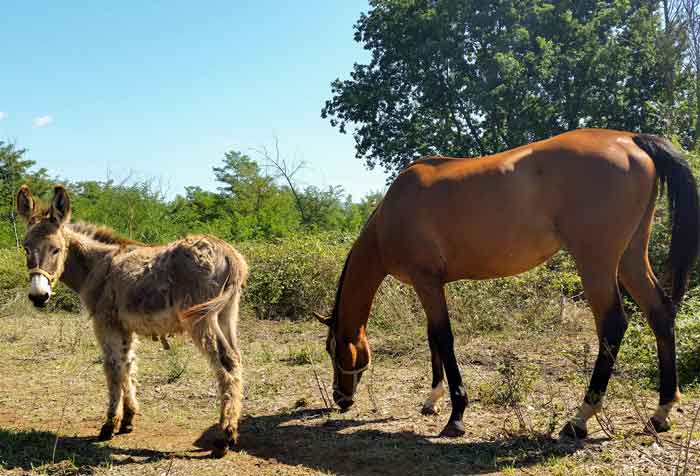Endurance races are tough long races of up to 100 miles (161 kilometers) or more. Only the toughest horses can do this and you need to train well in advance.
Can Quarter Horses Do Endurance Riding?
Quarter horses are primarily built for shorter distances and sprints. But there are several examples of quarter horses that do well at endurance races as well. They have bulky muscles and tend to heat up over long distances but they can be trained to do well at 50-mile races.
Here are exactly what you want to know about quarter horses and endurance riding.
Table of Contents
Are Quarter Horses Built For Endurance Riding?
Quarter horses have bulky muscles and they are as strong as they are tender. They are primarily used for two purposes:
- Short races
- Working with cattle
But that doesn’t mean that you cannot use a quarter horse for endurance riding. Though we haven’t seen a quarter horse win the Tevis Cup yet and we probably won’t see that ever.
People will often tell you that quarter horses are no good for endurance racing. But They have been proven wrong on many occasions. If you are looking for a new horse you should probably look at an Arabian horse. But if you already have a strong quarter horse with incredible endurance and a strong will to keep going you can definitely get great results with it too.
Quarter horses tend to have a strong will and they will not back down from a challenge if they feel that the rider enjoys working with them. They will need to be trained and conditioned well but they can make a great endurance horse.
That being said, it’s not that common. The reasons should be found in two different places:
- The tradition
People have always used Arabian horses and other sleeker horse breeds for endurance races. This means that people will often follow the tradition and choose these breeds (or similar) for endurance racing. - The way they are built
Quarter horses have typically been bred to be as bulky and strong as possible to work with cattle and to win short distance races.
Quarter horses are quite intelligent and great horses to work with and you can teach them a lot of things. But with horse breeds, certain things also comes down to genetics.
Quarter horses are built a little differently than the horse breeds we normally find among the winners at endurance races. The most typical horse breed to find at the “podium” at endurance racing is the Arabians, as we will look at in a minute.
Here are some main characteristics of how the quarter horse is built:
- Strong and bulky muscles
- Broad shoulders
- Strong hind legs
These three characteristics make them excellent at sprinting shorter distances and working with cattle. And when we are talking about endurance riding we are looking for a horse that can ride for many hours without getting tired or heating up.
This is something you can train your quarter horse to be better at. Did you will need to train hard in order to trim the horse and condition the body and the system to do well over long distances.
Arabian horses have longer muscles and they are not quite as bulky on the hindquarters as quarter horses. The same goes for thoroughbreds that also tend to be a little taller than quarter horses and have longer legs. Thoroughbreds are often used as racehorses as well.
How Many Miles Can Quarter Horses Ride?
Well-trained quarter horses can run a 50-mile endurance race or even a 100-mile race. They can do so in a day or two but you need to watch it carefully so it doesn’t overheat and the quarter horse will need to rest for several days after finishing long distances.
There are many examples of quarter horses finishing even the longer endurance races. And as many endurance riders will tell you: it’s about finishing, not winning.
Endurance races are hard on the rider as well as the horse.
It’s very important to start training the horse a long time in advance if you consider participating in one of the harder endurance races with your quarter horse. Naturally, the quarter horses would do really well over shorter distances but they need to learn how to do well on long distances.
So you need to train well and you need to condition your horse in order to complete one of the long races like the common American endurance races that are typically 50 (80 kilometers) or 100 miles (161 kilometers) long.
The trick is to not start sprinting at once but get the horse into a good rhythm that it can withstand for a long stretch. Quarter horses like to get a quick start and it’s important to keep it back at the beginning so it doesn’t heat up or gets tired too quickly.
The Best Horse Breeds For Endurance Races
The most common horse breed among the tracks for endurance races is the Arabian breed.
They are perfectly built in order to finish an endurance race with the best possible time. This is because they have some very unique characteristics when it comes to their genetic built:
- Long sleek muscles
- Good standard height
- The mind of a marathon runner
Because of these genetic advantages, people will often breed Arabian horses toward becoming the next champion. There’s so much tradition going into this equation and people will go a long way to find the very best horse suited for a specific race.
Check out this article where we lay out exactly which breeds that are best for endurance racing.
How To Get Into Endurance Racing?
Want to join the long races and ride distances of up to a hundred miles? Then endurance racing is made for you!
Here’s exactly how you get into it and how you get started with this sport.
Get the right horse
You can do this was practically any horse breed as long as the actual horse is not too heavy. You can even do it with ponies and the cute small horse breeds you just need more time to finish the race.
There is some genetics we need to think about here, but you can use any horse breed for endurance racing.
You need to make sure that the specific horse isn’t too heavy and you need to learn how it reacts when it is being pushed to its limits. But with proper training and conditioning, you can get far and teach most horses to do well over longer distances.
You should start by adding more and more length to the routes when you ride. You need to do this gradually just like a human would train for a marathon. These races are the marathon races among horses.
If you want to make sure your horse is a good fit for these kinds of races you should always consult a veterinarian first. They will know exactly what to expect from the horse and they can examine it to make sure it’s built for it. You shouldn’t push your horse too hard because it might not be made for these long-distance races.
Get the perfect saddle
Remember that you need a saddle which you can ride for a long time. And I’m not talking about the horse here, I’m talking about YOU as a rider. Endurance riding is as much as being about you as a rider as it is about the horse.
Remember that you will have to sit on the horse for many many hours so you need to sit comfortably and find a horse that fits you well.
You might need a custom-made saddle that is made to fit you as well as the horse perfectly.
The saddle is probably the most important part of succeeding for you as a rider. If you are not comfortable on the seat you will not endure 50 or 100 miles on a horseback.
Learn to ride with bags
There are several things you need to bring along when you are riding endurance races. So you need to get comfortable riding with quite a lot of stuff. This is also something you need to learn and be comfortable with.
Try to pack up everything in your bags.
You will need these things before you set off for the long distances:
For the horse:
- Hay and food
- Blankets
- Rain sheets
- Food for yourself
- Buckets
- Bottles
- Gloves
- Sponges
- Fly spray
- Grooming box
For you as the rider:
- Water bottles
- Snacks
- Sunscreen
- Energy bars
- Food
- Horse papers (passport etc.)
- Warm clothes
- Extra underwear
- Tent
- Directions or GPS






